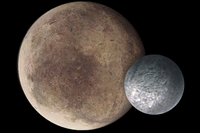1. As of 2006, Pluto is not longer considered a planet, but rather designated as a “dwarf planet,” meaning that it is a planetary-mass object being neither a planet nor a satellite. Pluto was declassified as a planet by the International Astronomical Union (IAU).
2. Pluto is the smallest dwarf planet in the Solar System, smaller than Earth’s Moon, and half the width of Jupiter’s moon, Ganymede.
3. Pluto’s journey around the Sun takes 248 Earth years. This means that, since its discovery in 1930, it still has over 160 years to go until it has made a complete orbit around the Sun.
4. Pluto’s atmosphere is composed of a thin layer of gas containing carbon monoxide, methane, and nitrogen. Its atmospheric pressure has been estimated to be 1/700,000 compared with that of earth.
5. Pluto orbits the Sun on a different plane than the 8 planets, going over them and below them.
6. Pluto has four identified moons, Charon, the largest is not much smaller than Pluto itself. (Pluto is 2,280 kilometers wide, Charon is 1,212 kilometers wide). The other 3 are Nix, Hydra, and newly discovered S/2011 P 1 on July of 2011.
7. A day on Pluto is equivalent to Earth’s 6 days and 9 hours, meaning that it has the second slowest rotation in the Solar System (after Venus, which takes 243 days to turn on its axis).
8. Pluto’s orbit is elliptical, meaning that it can come closer to the Sun than Neptune, but then go almost two billion kilometers further away from Neptune’s orbit.
9. Pluto is too faint to be seen with the naked eye. When viewed through a telescope, it looks like a star.
10. Pluto is cold: -233° C (-390° F), just 40° C (72° F) above absolute zero. At this temperature, all elements would be frozen except for neon, hydrogen, and helium.
11. Pluto maximum distance from the Sun – 7.38 billion km (4.6 billion miles).
12. Pluto’s minimum distance from Earth – 4.28 billion km (2.7 billion miles).
13. If you weigh 100 lbs, your weight on Pluto would be 7 lbs. (multiply your actual weight by .067).
14. When gazing at the Sun from Pluto it would appear as a tiny bright start because the two are so far away from each other.
15. According to some astronomers, Pluto used to be one of Neptune's moons, but it somehow broke out of its orbit.
16. Pluto was first located by Clyde Tombaugh in 1930.
17. One of the reasons why Pluto was declassified as a planet was because there are asteroids in the solar system that are bigger than Pluto.
18. Since being declassified as a planet, Pluto's technical name is now 134340.

